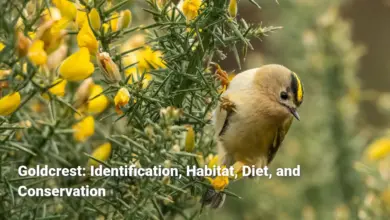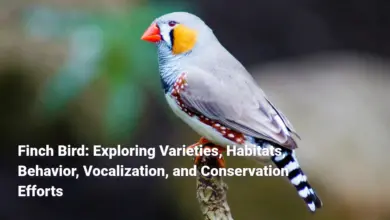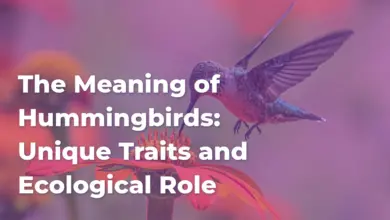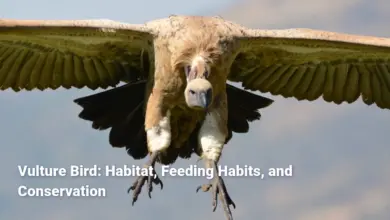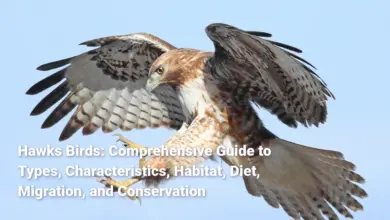Parrot Bird: Types, Habitat, Diet, Behavior, and Care
Parrot birds are one of the most captivating and intelligent creatures in the avian world, famously known for their brilliant hues, remarkable vocal abilities, and complex social behaviors. With over 350 species found primarily in tropical and subtropical regions, these birds vary greatly in size, color, and personality. Whether it’s the majestic macaw flaunting its vibrant plumage or the small budgerigar charming with its playful antics, parrot birds have established a significant footprint in both nature and human culture.
Their ability to mimic sounds and engage in social interactions not only makes them fascinating pets but also sheds light on the complexities of avian life and behavior. Parrot birds have become symbols in various cultures, often representing freedom, communication, and intelligence. This article aims to explore the diverse aspects of parrot bird life, from their habitats and dietary needs to their behavioral practices and cultural significance, providing a well-rounded understanding of these enchanting birds.
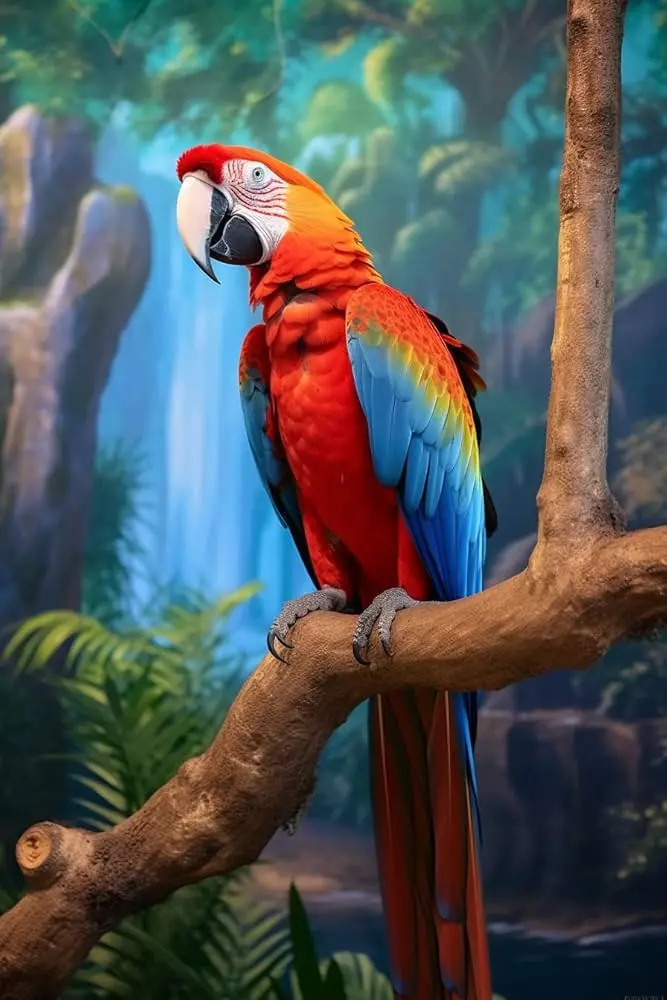
Types of Parrot Birds
Parrots consist of a wide variety of species, each demonstrating unique physical traits, behaviors, and adaptations. Much like a rich tapestry, the diversity within the parrot family showcases a spectrum of colors, sizes, and social structures, captivating enthusiasts and researchers alike.
To illustrate the classification of parrots, here’s a concise summary of a few notable types:
| Parrot Species | Size | Color Variation | Diet |
|---|---|---|---|
| African Grey Parrot | 30-35 cm | Grey with red tail | Seeds, nuts, fruits, veggies |
| Amazon Parrot | 25-46 cm | Green with yellow/blue | Fruits, seeds, veggies |
| Budgerigar (Budgie) | 18-20 cm | Green, yellow, blue | Seeds, fruits, veggies |
| Cockatiel | 30-35 cm | Grey, white, yellow | Seeds, fruits, veggies |
| Eclectus Parrot | 35-43 cm | Green (male), red (female) | Fruits, veggies, seeds |
| Sun Conure | 30 cm | Yellow-orange | Fruits, vegetables, seeds |
| Macaw | 60-100 cm | Multicolor (blue/red/yellow) | Nuts, seeds, fruits |
| Lovebird | 13-18 cm | Green, peach | Seeds, fruits, veggies |
This table provides a snapshot of just a small number of the many parrot species that exist. Each type showcases remarkable differences that influence their care requirements and interaction with surroundings.
Popular Parrot Bird Species
Among the vast array of parrot species, certain breeds have captured the hearts of bird lovers and pet owners worldwide. These popular parrot species not only stand out due to their vibrant colors but also for their unique behavioral traits.
- African Grey Parrot: Renowned for its exceptional intelligence, the African Grey can mimic a wide range of human speech and sounds. These parrots are predominantly grey with striking red tails, measuring about 30-35 cm in size. Their high intelligence makes them require considerable mental stimulation and social interaction to remain happy and healthy.
- Amazon Parrot: Characterized by their vivid green coloration, these parrots can reach sizes between 25-46 cm. Known for their playful and social demeanor, Amazon parrots often become vocal companions, almost cherishing any interaction they can get with humans.
- Budgerigar (Budgie): Ideal for first-time bird owners, budgerigars are tiny, colorful birds, approximately 18-20 cm long. They exhibit stunning color mutations and can easily learn to mimic human speech, making them popular pets for individuals looking for affectionate companionship.
- Cockatiel: With a distinct crest and a friendly disposition, cockatiels measure around 30-35 cm. Their ability to whistle and mimic sounds makes them endearing pets. They thrive on interaction and often develop strong bonds with their owners.
- Macaw: The true giants of the parrot world, macaws can range from 60 to 100 cm in length! They boast vibrant colors and require ample space to thrive. These intelligent and social birds are known for their captivating personalities and loud vocalizations.
Understanding the traits and needs of these popular parrot species is essential for responsible care and fostering healthy relationships. Each species has its distinct joys, challenges, and requirements, thus emphasizing the importance of tailored care for pet birds.
Rare Parrot Bird Species
Parrots are not just common companions; some species are rare and critically endangered, creating the urgency for conservation efforts. The following details some of the rarest parrot species and the threats they face.
- Puerto Rican Amazon (Amazona vittata): Once facing extinction, this species is native to Puerto Rico, with only about 50-100 surviving in the wild due to habitat destruction and hurricanes. Conservation programs seek to restore their population, aided by captive breeding initiatives.
- Imperial Amazon (Amazona imperialis): This parrot boasts a staggering beauty, known as the national bird of Dominica. With possibly fewer than 50 breeding pairs remaining, it faces threats from deforestation and tropical storms.
- Kākāpō (Strigops habroptila): A truly unique, flightless parrot endemic to New Zealand, its population hovered perilously close to extinction at around 148 individuals. Ongoing conservation efforts have been implemented, which include breeding programs to ensure genetic diversity.
- Spix’s Macaw (Cyanopsitta spixii): Once extinct in the wild, Spix’s Macaw exists solely in captivity, with around 60-80 individuals remaining. Intensive captive breeding and habitat recovery plans are underway.
- Orange-bellied Parrot (Neophema chrysogaster): Native to Australia and critically endangered, fewer than 30 birds are estimated to remain in the wild. Conservation efforts are essential to bolster their numbers and secure their future.
Endemic Parrot Birds Around the World
Endemic parrots represent a unique aspect of avian biodiversity, thriving in their specific habitats. Here’s a closer look at various endemic parrots and their native regions.
- Kea (Nestor notabilis): This playful parrot from New Zealand is known for its intelligence and curiosity. The Kea has adapted to the rugged mountainous terrains, showcasing a distinctive olive-green plumage.
- Kākāpō (Strigops habroptila): Also from New Zealand, the Kākāpō is notable for being nocturnal and flightless. Its complex mating call and bright green feathers make it an iconic symbol of conservation efforts.
- Sulu Racquet-tail (Prioniturus verticalis): Found exclusively on the Tawi-Tawi islands in the Philippines, this critically endangered bird is threatened by habitat loss. Its vibrant green and blue coloration makes it particularly striking.
- Guadalcanal Ground Parrot (Cyanoramphus spp.): An endemic species to the Solomon Islands, these parrots face threats from habitat destruction and introduced species. Their conservation status highlights the challenges faced by island-endemic birds.
- Pink Cockatoo (Cacatua leadbeateri): Native to Australia, this species is known for its stunning pink feathers and is often found in wooded areas. They exhibit strong social bonds, usually forming flocks that share resources.
Awareness of these endemic parrot species sheds light on the nuances of biodiversity and highlights urgent conservation needs placed upon these specialized birds. Protecting their habitats is crucial to ensuring their survival in a rapidly changing world.
Parrot Bird Habitat
The natural habitats of parrots are pivotal to their survival and overall well-being. Predominantly found in tropical and subtropical climates, these environments offer a diverse range of resources that meet their dietary, social, and nesting needs.
- Tropical Rainforests: The prime habitat for many parrot species, rainforests are rich in biodiversity. The dense foliage and towering trees provide shelter, nesting sites, and abundant food sources, particularly fruits and nuts.
- Forest Edges and Savannas: Parrots are also found in forest edges where they transition into open terrains, allowing them to exploit different food sources. Savannas are crucial habitats for species that adapt to more open landscapes, relying on grass seeds and shrubs.
- Urban Adaptations: Interestingly, some parrot species, such as the red-crowned parrot, have adapted to urban environments over time. They often thrive in parks and gardens, utilizing human-provided food sources while forming new social structures.
- Impact of Habitat Destruction: Unfortunately, deforestation, agricultural expansion, and human encroachment have severely impacted parrot habitats. These pressures contribute to population declines and increase the risk of extinction for many species.
- Conservation Importance: Protecting parrot habitats is essential for conservation efforts. Creating reserves, restoring degraded land, and fostering community involvement are critical steps in maintaining viable ecosystems for these vibrant birds.
Understanding the diverse habitats in which parrots thrive is fundamental for implementing effective conservation strategies and protecting the incredible biodiversity of these avian gems. Each ecosystem plays a critical role in sustaining the delicate balance that supports avian life.
Natural Habitats of Parrots
The natural habitats of parrots encompass a variety of ecosystems, with tropical rainforests being the most prominent. These vibrant environments are characterized by lush vegetation, towering trees, and complex ecosystems that provide numerous food sources, such as fruits, nuts, and edible blooms. Parrots are adapted to thrive in this rich biodiversity, showcasing remarkable skills in foraging and utilizing resources.
Tropical Rainforests and Their Importance
Tropical rainforests serve as the ideal habitat for numerous parrot species. With ample resources available, these ecosystems support high levels of avian biodiversity, allowing parrots to utilize their strong, curved beaks to crack open nuts and access nectar. The dense canopy offers protection from predators, while also facilitating social interactions within parrot groups.
Forest Edges and Open Habitats
In addition to rainforests, parrots can often be found in forest edges, where dense trees meet open areas. These zones are rich in food resources, creating ideal nesting conditions. Some parrots prefer savanna regions, taking advantage of grass seeds and foraging opportunities in a less dense environment. Their adaptability allows them to thrive in various habitats while exhibiting unique foraging patterns to suit their surroundings.
Urban Adaptations
Interestingly, certain parrot species exhibit adaptability to urban environments, showcasing their resilience as they navigate the challenges of city life. Urban parks and gardens provide unexpected coping mechanisms, allowing parrots to exploit artificial food offerings, such as ornamental plants, fruit trees, and human leftovers. These adaptations illustrate their remarkable intelligence, as they can shift their behaviors to survive in changing environments.
Parrots in Urban Areas
Urban adaptations in parrots provide a fascinating glimpse into their resilience and intelligence amidst rapid environmental changes. Parrots, particularly the red-crowned parrot, have successfully established themselves in urban settings, showcasing their adaptability against a backdrop of habitat loss and ecological challenges.
The Red-Crowned Parrot: A Case Study
This particular species has gained a foothold in urban areas of South Texas, where they have found refuge and resources amid human developments. The availability of ornamental plants in parks and gardens has been a vital food source, providing nourishment to these parrots. Additionally, urban infrastructure inadvertently creates nesting opportunities, such as tree cavities formed by woodpeckers, contributing to their burgeoning population in cities.
Research led by Texas A&M University highlights this urban-centric growth, which is a stark contrast to many parrot species facing declines elsewhere. Their newfound habitat success emphasizes the importance of considering urban environments in conservation planning.
Impacts of Human Development
While urban life offers opportunities for some parrot species, it can pose challenges for others. Factors such as pollution, human interaction, and predation risk can complicate their adaptation process. Moreover, habitat loss remains a significant threat, underscoring the necessity of preserving green spaces and protecting natural habitats.
Conservation Efforts
The increasing recognition of urban habitats in parrot conservation underscores a shift in environmental paradigms. Preserving urban biodiversity through habitat restoration and promoting awareness among local communities are critical steps in safeguarding these agile birds.
Through targeted efforts, it is possible to marry nature conservation with urban development by integrating parrot-friendly practices into municipal planning. By understanding the dynamics of urban ecosystems, communities can enhance the interactions between parrots and their human neighbors, ultimately fostering biodiversity even in densely populated areas.
Diet and Feeding Habits
Parrot feeding habits are as diverse as their colors, showcasing unique adaptations that reflect their environments. Within their natural habitats, these birds primarily consume a varied diet, which contributes to their well-being and vitality.
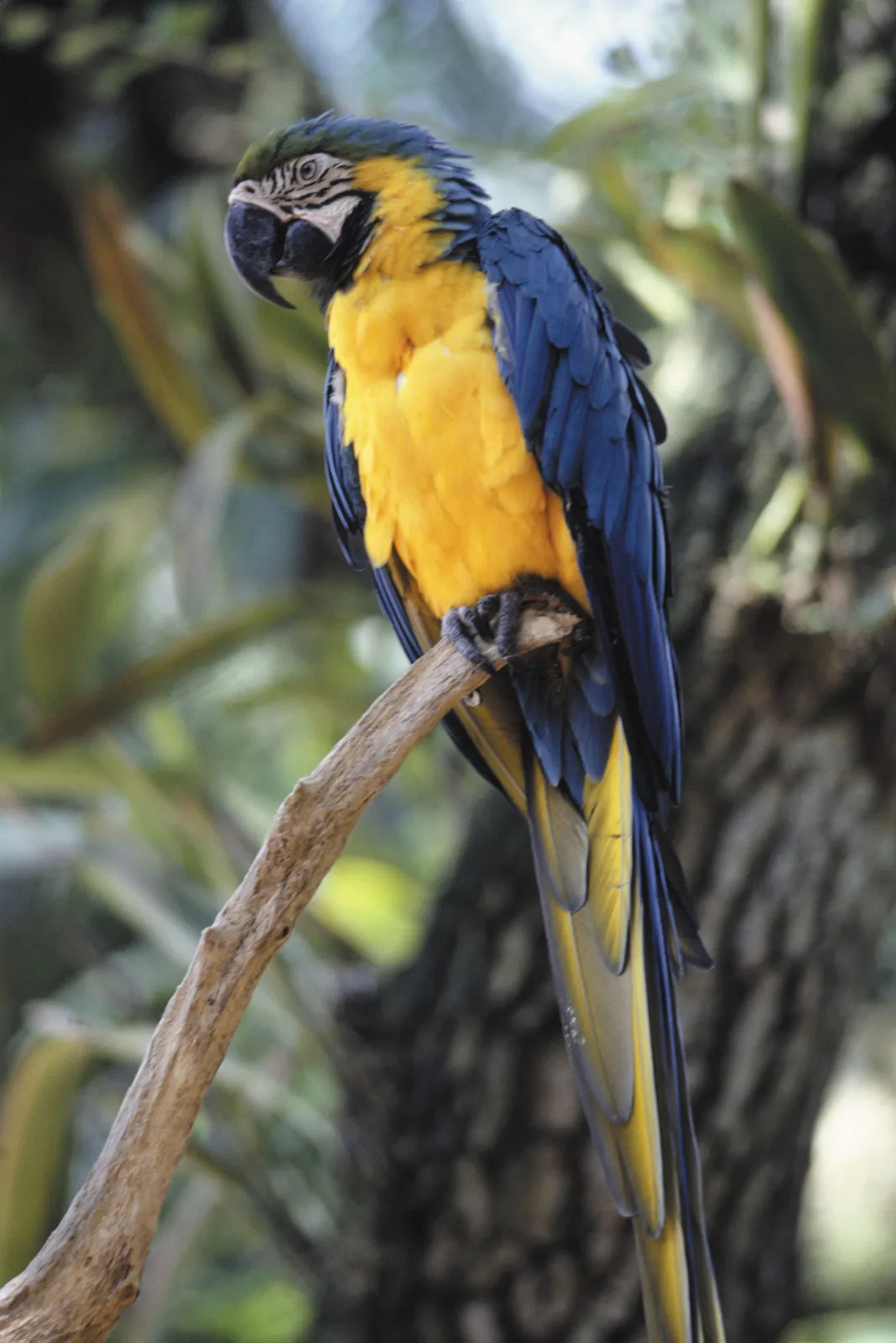
Natural Diet Composition
Parrots in the wild thrive on a rich assortment of food, including fruits, seeds, nuts, flowers, leaves, and even insects. This varied diet helps them obtain essential nutrients vital for their health. Their strong beaks allow them to crack tough seeds and open hard fruits while showcasing their clever foraging techniques.
Feeding Behavior Insights
As natural foragers, parrots typically spend significant portions of their day searching for foods. They have evolved specialized behaviors to access their dietary needs. African Grey parrots, for instance, are particularly adept at working through complex tasks to procure food, showcasing both intelligence and dexterity.
Dietary Preferences by Species
Different parrot species exhibit specific dietary preferences based on their habitats, leading to unique feeding behaviors:
- Fruit Eaters: Birds like the Eclectus thrive primarily on fruits thanks to their digestive systems designed to process high sugar content.
- Seed Eaters: Larger macaw species often prefer seeds and nuts rich in fats, essential for their energy needs.
- Nectar Feeders: Lorikeets and lories have specialized tongues for sipping nectar, demonstrating evolutionary adaptations tailored to their food sources.
Hydration Needs
Access to fresh water is critical for parrots’ daily functioning. Besides drinking, parrots often obtain hydration from water-rich fruits, enhancing their overall well-being.
Essential Nutritional Balance
Parrots in captivity require diets replicating their natural nutritional needs to flourish. High-quality pellets, fortified with essential vitamins and minerals, should form the basis of their diet. Fresh fruits and vegetables will enhance their meal plans, while seeds and nuts should only comprise a small percentage due to their high-fat content.
Caution with Foods
Understanding which foods can harm parrots is essential for caretakers. Foods like chocolate, avocado, and certain seeds contain toxic components that can adversely affect a parrot’s health. Regular consultation with an avian veterinarian is essential to ensure a balanced diet aligned with specific species’ requirements.
By providing parrots with a well-rounded diet that emulates their natural feeding behaviors, caregivers can support their physical health and enrich their mental well-being. Regularly introducing new food items can also keep them engaged and excited about their meals.
Foods Safe for Domesticated Parrots
Feeding domesticated parrots is a significant responsibility, requiring awareness of their nutritional needs and dietary restrictions. A carefully planned diet ensures the overall health and well-being of these intelligent and social creatures.
Safe Food Options
- Pellets: The foundation of a parrot’s diet should be high-quality commercial pellets, making up 50-70% of their total food intake. These pellets are specifically formulated to meet the essential nutritional needs of parrots, providing vitamins and minerals without unnecessary additives.
- Fresh Fruits and Vegetables: Incorporating fresh produce is crucial for hydration and essential nutrients. A blend of colorful fruits such as apples, berries, and bananas, along with vegetables like kale and carrots, should comprise 30-50% of their total diet. Ideally, vegetables should make up a larger portion than fruits.
- Seeds and Nuts: While seeds and nuts can be tasty treats, they should account for only 10-20% of a parrot’s diet because of their high fat content. Opting for a variety of seeds, while avoiding peanuts due to aflatoxin risks, can offer a healthier balance.
- Legumes and Grains: Incorporating cooked legumes and grains adds essential protein to the diet, contributing beneficial nutrients. Foods such as lentils, chickpeas, quinoa, and cooked brown rice can be valuable inclusions.
- Toxic Foods to Avoid: Caregivers must be vigilant about foods that are harmful to parrots. These include avocado, chocolate, caffeine, and various fruit seeds, including those from apples and cherries.
Feeding Habits
Establishing a consistent feeding routine helps create a healthy environment for domesticated parrots. Discarding uneaten portions ensures freshness, while providing ample water at all times is vital for hydration.
Feeding practices may include preparing “chop,” a mix of fruits, vegetables, grains, and legumes, which can create balanced meals throughout the week, maintaining variety and excitement in the parrot’s diet. Regularly assessing dietary needs and altering the menu can contribute significantly to the happiness and health of these remarkable birds.
Nutritional Needs of Parrots
Caring for parrots goes beyond sustenance; it encompasses an understanding of their nutritional needs, which are crucial for their health and longevity. A balanced diet that mimics their natural intake is vital for maintaining their vibrant colors and active behaviors.
Understanding a Balanced Diet
Parrots in the wild consume a diverse diet, consisting of fruits, seeds, nuts, flowers, nectar, and occasionally small insects. These foods provide a well-rounded nutritional profile essential for their well-being. In captivity, replicating this diversity is critical to ensuring that parrots receive adequate vitamins and minerals.
Key Nutritional Components
- Proteins: Protein is vital for building and repairing tissues, facilitating growth, and maintaining a healthy immune system. Sources include whole grains, legumes, and specific formulated pellets.
- Vitamins and Minerals: Fresh fruits and vegetables are rich in essential vitamins, especially vitamin A and C, which are crucial for maintaining optimal health. Pellets, designed to include added vitamins, play a significant role in fulfilling these needs.
- Fats: While fats are essential for energy, they must be carefully monitored. Seeds and nuts contain high-fat content; thus, their intake should be limited to prevent obesity and associated health complications.
- Water: Fresh, clean water should be available at all times. Parrots often obtain moisture from various foods as well, particularly water-rich fruits.
Dietary Imbalance Consequences
Neglecting the importance of a balanced diet can lead to various health issues, including malnutrition, obesity, feather plucking, and even organ failures. To prevent these issues, caregivers must provide a consistent and balanced selection of food items, monitoring intake, and adjusting the diet as necessary.
Regular Consultation
Consulting with an avian veterinarian is essential for receiving personalized dietary recommendations based on individual parrot species and health conditions. Careful attention to nutrient balance can ensure that parrots thrive in a stimulating, health-focused environment.
Understanding parrots’ nutritional needs helps caregivers create well-rounded diets that enhance their quality of life while ensuring that these amazing birds continue to flourish for years to come.
Parrot Behavior
Parrots exhibit a range of behaviors shaped by their social structures and environmental interactions. Studying these behaviors offers vital insights into their needs, providing opportunities for enhanced care and companionship.
Social Behavior Insights
Parrots are inherently social creatures, forming complex relationships and strong bonds with their companions, whether fellow birds or humans. Understanding their social dynamics is paramount to fostering healthy environments and minimizing stress.
- Pair Bonding: Many parrots engage in strong pair bonds, often choosing mates for life. This bond forms the foundation of their social structure and influences behaviors, such as mutual preening and cooperative play.
- Hierarchical Structures: Parrots establish social hierarchies within their flocks. Researchers have noted dominance behaviors that influence feeding order and mating practices. Recognizing these dynamics can aid in promoting harmony among captive parrot populations.
- Memory and Learning: Parrots possess remarkable cognitive abilities, enabling them to navigate complex social interactions. Their memory plays a crucial role in recognizing individuals and recalling past experiences, essential for their social learning.
- Vocal Communication: Communication encompasses an extensive range of vocalizations. Parrots use various squawks, whistles, and calls to convey emotions, vocalize their needs, and strengthen social ties. Encouraging vocal communication can contribute significantly to behavioral wellbeing.
Behavioral Enrichment
To support the mental and emotional well-being of parrots, enriching their environments with stimulating activities and interactions is essential. Providing varied toys, social engagement, puzzles, and opportunities for exploration fosters healthy behaviors while reducing potential stressors.
Creating a structured routine that encourages interaction, exploration, and problem-solving helps parrots feel secure and content in their environment, reinforcing the human-animal bond.
Social Behavior in Parrots
Social behavior is at the core of parrot identity, influencing their interactions within groups and their abilities to communicate effectively. Understanding these behaviors will empower owners to foster well-adjusted and happy companions.
Social Interaction Patterns
Parrots are known for their intricate social dynamics, establishing relationships with both each other and humans. Observing these interactions provides insights into their personalities and individual needs.
- Flight Patterns: In the wild, flocks of parrots often exhibit coordinated flight, signaling their social cohesion. Observing how captive parrots engage in play and exercise can reveal their levels of comfort within an environment.
- Vocal Engagement: Vocal interactions among parrots within groups help reinforce social bonds. Owners can utilize this aspect to encourage vocalization within their pets, serving as a bridge for communication.
- Grooming Rituals: Parrots often groom one another in bonded pairs, showcasing trust and care, reinforcing social connections. Encouraging similar behaviors between birds and their owners strengthens the human-pet bond.
Teaching Positive Social Structure
Promoting positive social behavior in captive parrots involves understanding their innate social needs. Implementing structured socialization experiences, such as supervised bonding with other birds or gradual exposure to novel environments, can lead to reduced stress and enhanced wellbeing.
Developing Social Structures in Captivity
For those keeping parrots as pets, developing social networks within captivity can mimic their natural behavior. Regular interaction with the owner and, if possible, other compatible birds facilitates comfort and security. However, owners must maintain proper control of interactions to avoid aggression or territorial disputes among birds.
Engaging parrots socially ensures their mental and emotional health thrives, significantly improving their overall quality of life in captivity.
Communication Methods of Parrots
Parrots are exceptional communicators, utilizing a variety of methods to express their needs, emotions, and social hierarchies. Understanding these communication methods enhances the caregiver-parrot relationship and promotes seamless interactions.
- Vocal Versatility: Most parrots possess the unique ability to mimic sounds they hear in their environment, including human speech. This vocal mimicry serves as both a bonding mechanism and a way to establish social connections.
- Body Language: Beyond vocalizations, body language plays a critical role in parrot communication. Parrots may use puffed feathers, wing movements, and physical posturing to convey feelings, such as aggression, excitement, or contentment.
- Mimicking Skills: Reinforcing vocal interactions with training can enhance a parrot’s ability to mimic phrases and cues. Through positive reinforcement, caregivers can teach parrots specific words or phrases, further fostering their socialization skills.
- Social Grooming: Grooming behavior serves as a form of social bonding and communication. Parrots engage in mutual grooming to provide reassurance and reinforce emotional connections.
- Facial Expressions: Parrots display various facial expressions signaling their feelings. Recognizing these nuances aids caregivers in understanding their mood and needs.
Understanding parrots’ diverse communication methods fosters deeper connections between birds and their caretakers, contributing positively to both parties’ emotional wellbeing.
Playful Activities of Parrots
Play is a fundamental aspect of parrot life, providing opportunities for physical and mental stimulation while reinforcing social bonds. Engaging in various activities enriches their natural behavior patterns, supporting healthy lifestyles.
- Interactive Play: Parrots thrive on interactive play, whether with toys or their caretakers. Introducing toys that challenge their intellect, such as puzzle feeders and foraging toys, can keep parrots engaged while satisfying their innate curiosity.
- Social Games: Parrots enjoy social games that involve interaction with other birds or humans. Activities such as fetch, or hide-and-seek with treats, can enhance their playful spirit and strengthen social bonds.
- Exploration Activities: Enriching parrots’ environments encourages exploration. Allowing safe access to open spaces or climbing structures not only keeps them entertained but also fosters their natural tendencies to investigate their surroundings.
- Physical Exercise: Encouraging flight and climbing activities significantly benefits a parrot’s health. Regular supervised outdoor exercise and opportunities to navigate climbing structures enhance their physical fitness and mental stimulation.
- Sensory Engagement: Introducing audiovisual stimuli, such as gentle music or nature sounds, can pique a parrot’s interest. Creatively integrating new elements into their environment provides dynamic engagement that captivates their senses.
Incorporating playful activities into a parrot’s routine nurtures their natural instincts and keeps them emotionally and physically stimulated, leading to happy, healthy companions.
Parrot Care
Taking care of a parrot involves understanding their unique needs and ensuring their well-being. A happy and healthy parrot requires proper diet, social interaction, and a suitable living environment.
Essential Care Tips for Parrots
- Choosing the Right Species: Each parrot species has distinct requirements and instincts. Consider aspects such as size, temperament, and vocalization when selecting a parrot suitable for your lifestyle.
- Balanced Diet: A well-balanced diet includes high-quality pellets (60-80% of daily intake) supplemented with fresh fruits and vegetables (15-20%). Monitor seed and nut inclusion, limiting them to around 10% due to high-fat content.
- Housing Conditions: Providing a spacious cage with appropriate bar spacing is vital for their physical health. Select safe materials that prevent injury, and incorporate plenty of perches, toys, and stimulating environments.
- Cleanliness and Hygiene: Maintain a regular cleaning routine to prevent disease. Offer fresh water daily and provide opportunities for bathing to keep feathers in optimal condition.
- Social Interaction: Parrots are social creatures requiring daily interaction for emotional health. Engaging them with human companionship or social playtime with other parrots is necessary for their happiness.
- Health Monitoring: Regular veterinary check-ups ensure early identification of health issues. Monitor for behavioral changes, such as diet changes or feather condition, signaling potential health concerns.
- Behavioral Training: Utilize positive reinforcement in training sessions, focusing on building trust. Regular training can foster strong bonds and address behavioral issues like biting or stress-related vocalizations.
By implementing these care tips into daily routines, caregivers can create nurturing environments that meet the needs of their parrots, fostering fulfillment and comfort.
Housing Requirements for Pet Parrots
Creating the ideal housing environment for pet parrots is essential for their physical and emotional health. The right cage and living space will allow them to thrive and feel secure.
- Cage Size: The cage should be spacious enough to allow for stretching wings and engaging in playful behaviors. As a general rule, width should exceed height to enable horizontal movement, which is natural for parrots.
- Bar Spacing and Material: The spacing between the bars must allow the parrot to perch comfortably while preventing head entrapment. Safe materials for the cage include stainless steel and untreated wood, avoiding toxic metals like lead and zinc.
- Interior Setup: Incorporate various perches of different diameters and textures. Natural branches, cotton ropes, and other safe climbing materials encourage physical activity.
- Ventilation and Light: Good ventilation and exposure to natural light are essential for a healthy environment. Ensure cages are placed in well-lit areas where parrots can receive direct sunlight but also have access to shaded spots.
- Health Risks: Poor housing conditions can lead to various health risks. Regular cleaning and monitoring for hygiene support a healthy living environment, ensuring a clean habitat prevents respiratory problems and infections.
Providing the right housing requirements will significantly impact a parrot’s overall health and happiness, ensuring that they can flourish as beloved companions.
Health Issues in Parrots
Understanding potential health issues in parrots is crucial for maintaining their well-being. Regular observation and proactive care can prevent significant health complications as they age.
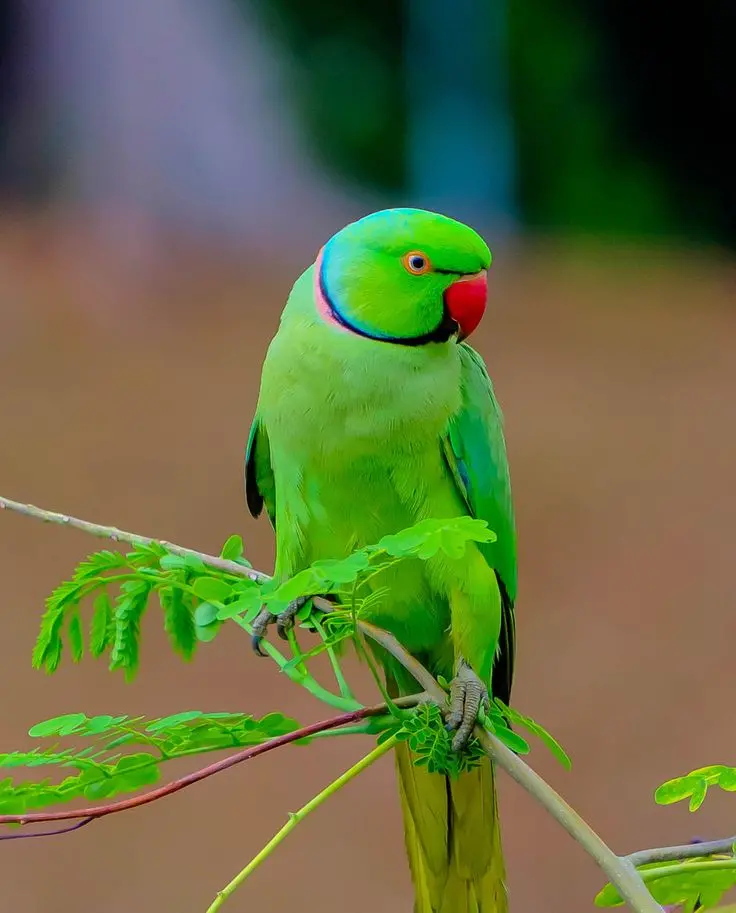
- Respiratory Infections: Parrots are particularly susceptible to respiratory infections caused by environmental factors, such as dust, smoke, and poor ventilation. Ensuring clean living spaces and avoiding exposure to toxins is essential for reducing respiratory risks.
- Nutritional Deficiencies: An unbalanced diet can lead to treatments, impacting overall health. Common deficiencies include vitamin A, calcium, and protein deficits, leading to feather plucking, beak deformities, and even organ failures.
- Obesity Issues: Overfeeding high-fat foods or failing to promote exercise can result in obesity, which is linked to various health conditions, such as heart problems and liver disease. Careful dietary management and engaging activities are crucial.
- Feather Plucking: This behavioral issue may indicate stress, boredom, or medical problems. Observing behavioral changes and providing social interaction can help mitigate feather plucking tendencies.
- Common Diseases: Knowledge of common diseases, such as psittacine beak and feather disease, viral infections, and bacterial diseases, is vital for proper care. Regular veterinary check-ups aid in early detection.
Monitoring and recognizing behavioral patterns can also assist in identifying health issues early. Proactive care ensures a longer, healthier life for pet parrots.
Training Parrots
Training parrots fosters a strong caregiver-bird bond and enhances their ownership experience. Understanding effective training techniques is key to responsible parrot care.
Basic Commands for Parrots
- Step Up: Teaching “step up” is essential for encouraging your parrot to move onto your hand or a perch. Hold your hand close and gently press against their chest while saying “step up,” rewarding them for compliance.
- Step Down: This command facilitates returning to a perch or your hand, reinforcing trust. Use similar techniques as the “step up” command.
- Come: Calling your parrot by name followed by “come” builds trust and assures safety. Reward them when they approach.
- Stay: Introduce the “stay” command gradually, rewarding them for remaining in place while you move away.
- No: Establish boundaries by using a firm tone to communicate “no.” Redirect their attention when undesirable behaviors arise.
Training Techniques
- Positive Reinforcement: Using treats and praise for desired behaviors fosters a trusting relationship. Reward the desired behavior immediately for the best results.
- Consistency: Using the same commands and training routines helps parrots learn better. Consistent reinforcement will solidify their understanding.
- Short Sessions: Keep training sessions around 10-15 minutes to maintain focus and alleviate stress. Frequent, brief sessions are generally more effective.
To ensure an enriching training experience, caregivers can explore various resources, including instructional guides and online platforms, that offer insights into effective training methods and techniques tailored to meet parrot-specific needs.
Behavioral Training Techniques
Effective behavioral training techniques enhance parrot-owner relationships, ensuring parrots live harmoniously in their environments. Training focuses on understanding behaviors, employing positive reinforcement, and addressing any behavioral challenges.
- Understanding Behavior: Parrots exhibit various behaviors that can indicate their emotional states. By understanding body language like ruffled feathers or flapping wings owners can respond appropriately, reducing the likelihood of negative behaviors developing.
- Positive Reinforcement: Positive reinforcement stands at the center of behavioral training, rewarding desired behaviors to strengthen desired actions. Providing treats, praise, or playtime encourages parrots to repeat the actions that resulted in positive feedback.
- Establishing a Routine: Routine training sessions help alleviate anxiety while allowing parrots to predict their interactions. Familiarity aids in creating a stable environment where they feel comfortable learning and growing.
- Addressing Undesired Behaviors: Identifying triggers of behaviors such as biting or aggression allows caregivers to create redirection strategies. Calming techniques and providing engaging alternatives can significantly reduce unwanted behaviors.
- Engagement through Enrichment: Incorporating enrichment activities into daily routines promotes mental stimulation. Activities like foraging toys and interactive games offer both entertainment and behavioral development opportunities.
By prioritizing these behavioral training techniques, caregivers will not only foster meaningful relationships but also create a safe, nurturing environment conducive to a parrot’s emotional and social needs.
Parrots in Culture
Parrots are woven into the cultural tapestry of various societies, representing concepts like communication, adventure, and beauty. They are central figures in folklore, art, and literature, captivating human imagination throughout history.
Symbolism of Parrots in Various Cultures
- Native American Culture: Parrots symbolize communication and storytelling, serving as council members in certain tribes, bringing messages of wisdom.
- Hinduism: In Hindu tradition, parrots signify love and fertility, often depicted alongside romantic deities.
- Chinese Culture: Parrots are seen as auspicious creatures, symbolizing happiness, good fortune, and joyful communication.
- Greek Mythology: Parrots serve as messengers of the goddess Hera, representing love and understanding.
- South American Native Traditions: Indigenous cultures view parrots as vital messengers, maintaining social structures and cultural narratives.
- Pirate Lore: Frequently associated with exploration, parrots represent adventure and freedom in popular culture.
Parrots carry rich symbolic meanings, resonating with their vibrant colors and social behaviors, captivating human communities across time.
Parrots in Literature and Art
Parrots have significantly influenced literature, art, and cultural expressions. They symbolize beauty and intricate relationships, often representing humanity’s fascination with nature and freedom.
- Literary References: Through centuries, authors such as Aristotle and Shakespeare have featured parrots as symbols of curiosity and communication. Their ability to mimic human words often reflects themes of love and companionship.
- Artistic Depictions: Parrots grace artworks from the Renaissance to contemporary art, representing the exotic and celebrating the diversity of life.
- Portrayals in Modern Media: In current culture, parrots are often celebrated in advertisements and popular films, reinforcing their connection to companionship and adventure.
Parrots as Pets in Different Societies
The status of parrots as pets varies across cultures. They symbolize companionship and emotional support, with their popularity growing globally.
- Cultural Significance: In many societies, owning a parrot reflects a sign of wealth and luxury, enhancing social status.
- Bonding Connections: As club pets, parrots serve as lively companions, contributing to emotional well-being and social interactions within families.
- Challenges of Ownership: Attention to conservation and ethical considerations is increasing, encouraging responsible pet ownership practices while ensuring a sustainable future for wild parrot populations.
In exploring how parrots intersect with culture, it becomes clear that these birds have left an enduring mark on humanity’s shared narrative, enriching lives and inspiring stories.
The exploration of parrots reveals their profound significance in nature, society, and culture. Their vibrant existence, captivating behaviors, and adaptability to various environments highlight the need for continued conservation efforts. By appreciating and protecting these exquisite creatures, we ensure that future generations can relish in their magnificence and charm.





